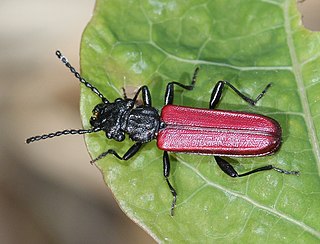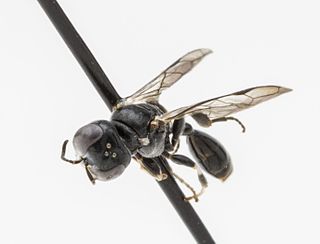
The Cucujidae, "flat bark beetles," are a family of distinctively flat beetles found worldwide under the bark of dead trees. The family has received considerable taxonomic attention in recent years and now consists of 59 species distributed in four genera. It was indicated Cucujus species are scavengers, only feeding on pupae and larvae of other insects and on other subcortical beetles such as their own. Since the Cucujidae prey on larvae of potentially tree damaging beetles that spread fungal diseases, they are considered to be beneficial to the health of living trees.

Clitocybe is a genus of mushrooms characterized by white, off-white, buff, cream, pink, or light-yellow spores, gills running down the stem, and pale white to brown or lilac coloration. They are primarily saprotrophic, decomposing forest ground litter. There are estimated to be around 300 species in the widespread genus.

Trichonephila clavipes, commonly known as the golden silk orb-weaver, golden silk spider, or banana spider, is an orb-weaving spider species which inhabits forests and wooded areas ranging from the southern US to Argentina. In fact, it is the only species of the genus Trichonephila indigenous to continental North and South America. Known for the golden color of their silk, the large size of their females, and their distinctive red-brown and yellow coloring, T. clavipes construct large, asymmetrical circular webs attached to trees and low shrubs in woods to catch small- and medium-size flying prey, mostly insects. They are excellent web-builders, producing and utilizing seven different types of silk, and they subdue their prey by injecting them with venom, as opposed to related species which immobilize their prey by wrapping them in silk first. They are not known to be aggressive towards humans, only biting out of self-defense if touched, and their relatively harmless venom has a low toxicity, posing little health concern to healthy human adults. Due to their prevalence in forests, T. clavipes may be encountered by hikers.

Aellopos clavipes, also known as the clavipes sphinx, is a moth of the family Sphingidae.

Gymnosporangium clavipes is a plant pathogen, a fungus that causes cedar-quince rust. Similar to Gymnosporangium juniperi-virginianae and Gymnosporangium globosum, the fungus infects a wide range of Rosaceae, such as apple, hawthorn and quince trees, and also requires an evergreen host such as eastern red cedar or a number of other juniper species to complete its life cycle.

Cucujus is a genus of beetles in the family Cucujidae, the flat bark beetles. It contains 19 currently recognized species and subspecies.

The genus Aellopos consists of large day-flying moths in the family Sphingidae. It was first described by Jacob Hübner in 1819. Species in this genus occur from Maine in the United States through Central America and down to Argentina and Uruguay in South America.

Ampulloclitocybe clavipes, commonly known as the club-foot or club-footed clitocybe, is a species of gilled mushroom from Europe and North America. The grey brown mushrooms have yellowish decurrent gills and a bulbous stalk, and are found in deciduous and conifer woodlands. Although considered edible, disulfiram-like reactions have been reported after consumption of alcohol after eating this mushroom.
Ptinus clavipes is a species of spider beetle in the family Ptinidae.
Coscinum is a genus of picture-winged flies in the family Ulidiidae.
Coscinum clavipes is a species of ulidiid or picture-winged fly in the genus Coscinum of the family Tephritidae.

Acanthoderini is a tribe of longhorn beetles of the subfamily Lamiinae. It was described by Thomson in 1860.

Aegomorphus is a large genus of beetles in the family Cerambycidae.
Poliopastea clavipes is a moth in the subfamily Arctiinae. It was described by Jean Baptiste Boisduval in 1870. It is found from Texas, Mexico, Guatemala and Costa Rica to Venezuela.
Cleptosoma clavipes is a species of beetle in the family Cerambycidae, and the only species in the genus Cleptosoma. It was described by Blanchard in 1851.
Gonatopus clavipes is a species of small wasp in the family Dryinidae. It is a solitary wasp that superficially resembles an ant, and its larva is a parasitoid of leafhoppers in the subfamily Deltocephalinae. It has a Palearctic distribution, and within Europe parasitises at least eleven genera and thirty-one species of leafhopper.

Dolichopus clavipes is a species of fly in the family Dolichopodidae. It is found in the Palearctic.

Cucujus clavipes is known as the flat bark beetle. It is found throughout North America. These are generally found near tree line under bark of dead poplar and ash trees. C. clavipes are described as phloem-feeding and often predators of other small insects, such as wood-boring beetles, and mites. These are usually seen during spring-summer seasons. Having a cold habitat, these beetles must go through several physiological mechanisms to survive; they are recognised for their ability to change their overwintering mechanisms.

Rhopalum clavipes is a species of square-headed wasp in the family Crabronidae. It is found in Europe, Northern Asia and North America.
Deuteronoda is a genus of leaf beetles in the subfamily Eumolpinae. They are known from Central America and South America.











